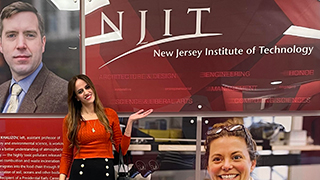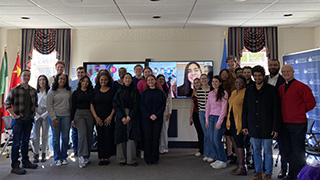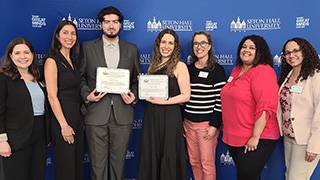Inside the Core
Tuesday, October 22, 2024
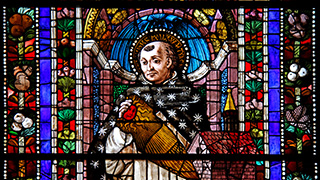
Thomas Aquinas
Inside the Core this week, in my Core I class, we read Hayy Ibn Yaqzan by the twelfth-century Islamic philosopher and polymath Ibn Tufayl. This interesting text is considered the first “philosophical novel” as it explores important questions regarding truth, how humans come to know it and how, ultimately, they come to know God. It tells the story of a feral human, born or left on a deserted island (with two possible versions of his birth given). Raised by a loving doe, he grows up like a young deer, but as he grows, he learns more and more about his world, including some attributes that make him more human: he can use his hands nimbly and successfully to make tools; he can compensate for lack of speed, compared to other creatures, by riding on a horse; he discovers fire and learns how to make use of it.
Philosophy comes into the story when Hayy begins to question his origins and that of the world/universe overall. Ultimately, we see that reason and a combination of philosophy and scientific observation lead him to a belief in a Creator, what Tufayl calls the Necessarily Existent Being. Here the story is reminiscent of Plato’s Allegory of the Cave, an earlier reading in Core I, where the cave dwellers move from shadows to the world of light, representing a movement from illusion to the Truth, and, ultimately, what we would call God. In both cases, reason leads to belief. However, Ibn Tufayl shows that there is more to the experience of God than we can reach by reason. He uses the word “ecstasy” to describe the experience of God that is beyond reason and even beyond words. As Ibn Tufayl says, “It is a necessary condition of what is reached by pure reason that it be true and valid. Thus the difference between the rationalist and those who enjoy intimacy is that while both are concerned with the self-same things, the latter enjoy a clearer view and far greater delight” (98). Reason is affirmed but shown to be unable to reach the heights of intimacy with God.
This Islamic text links with the experience of Christians such as St. Thomas Aquinas, an author read in Core II, who wrote in depth and clarity about theology, with the inclusion of the thought of Aristotle and his philosophy, but who affirmed at the end of his life, “Everything that I have written seems like straw to me compared to those things that I have seen and have been revealed to me” (quoted in many venues). What did Thomas experience? Something that was so precious and indescribable that it was beyond reason. In Core II, where we read Aquinas, this topic can be explored further, especially when his works are read in light of the Christian mystics, Julian of Norwich and Hildegard of Bingen. They experienced what might be called ecstasy and certainly intimacy with God that went beyond where reason could take them.
Clearly, none of these writers, particularly those like Ibn Tufayl and Thomas Aquinas, who were scholars and acquainted with such works as those of Plato and Aristotle, would not dismiss reason as invalid. The classic texts brought into the west, first by Islamic scholars, and then adopted into their own theologies by both Jews and Christians (like Aquinas or the Jewish scholar, Moses Maimonides, also read in Core II), had a large impact on all three faiths, and reason is central to the pursuit of truth in them. However, there is something beyond reason, Someone whose transcendence and beauty exist beyond where we can go through our own mental faculties. There is a quality of gift about it, a sense of grace, as one of my students mentioned specifically with regard to Christ and the gift of salvation as understood by Christians, that we cannot earn or think our way into. It simply must be received.
Finally, Tufayl also shows a natural world that welcomes and needs to be nurtured by humans. This is part of the gift given to humanity by God; ultimately, there is ecstasy in the final stages of movement toward God but, God has also given humans a home shared with other creatures, who should be valued by us and who can help us in our turn (as the doe helps Hayy in the story). This can be and often is a part of our journey of transformation, as we see in the story of Hayy Ibn Yaqzan. A similar Christian story is that of Saint Egidio (or St. Giles in English), for whom the Sanit’ Egidio prayer community is named.
-We have a branch of this international organization here at Seton Hall that meets at 4 p.m. on Thursdays in Xavier Chapel during the academic year-
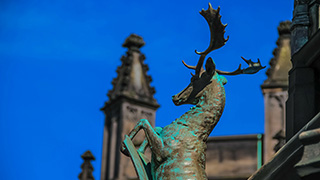
Deer statue at St. Giles Cathedral
The story goes that Saint Egidio was a hermit, befriended by a deer, who even fed him from her milk (as the doe feeds the young Hayy Yaqzan). When a hunter sought to kill the deer, Saint Egidio put up his hand, and the arrow pierced him instead of the deer. He is often depicted with a deer, sometimes with the arrow in his hand.
This story links to the Islamic tale of the young boy raised by a deer in that both show a spiritual connection between humans and animals, a link personified by another Christian saint, recently celebrated, Francis of Assisi (whose feast day was October 4). The human and animal/nature connection is very important in all three Abrahamic faiths, going back to the creation story, found in Christian and Jewish Bibles in the book of Genesis. Returning to the larger philosophical theme of the work by Tufayl, nature also can be analyzed in terms of reason, a scientific study that can teach us much. Ibn Tufayl was, in fact, also a doctor. But just as intimacy with God goes beyond reason, so nature also is best appreciated not only by scientific inquiry but by love. And love for God’s creatures, whether vegetative, animal or human, is linked to the love of God himself. It is not the same as ecstasy or mystical union with God, but love of nature can be a fitting backdrop for such encounters (as hermits have experienced, even including St. Francis when he received the stigmata in a cave, living in the natural world he so loved). For Hildegard of Bingen, one of the mystics mentioned earlier, the natural world and a mystical love of God were inter-connected, as she also was interested in nature and sources of healing from it (a kind of medical practitioner herself). And Pope Francis also wrote Laudato Si in the spirit of St. Francis, linking love for nature with a profound love for God and neighbor. This text also is read in Core II.
So, weaving these threads together, what do we see? First, we see inter-religious dialogue, where texts from different faiths link together in meaningful ways. Second, we see how a theme throughout the Core is the connection between faith and reason, with many religious writers affirming the latter, but also acknowledging that faith can and does go beyond reason. When we read Dante (soon) in Core I, that will become even more apparent as we see that Dante is guided by Virgil, a representative of human wisdom, which can take him far, but Beatrice, who represents God’s love, must take him into Paradise. Third, in all these texts, nature is linked always to God, with human beings learning something about God through His creation. During this time of year, when nature is outdoing itself in showing the beauty of the changing leaves, it is a good time to think about what faith has to say about the Author of such beauty, as St. Augustine of Hippo (yet another author from Core I and Core II) calls Him – “O Beauty, so ancient and so new.”
Categories: Faith and Service


